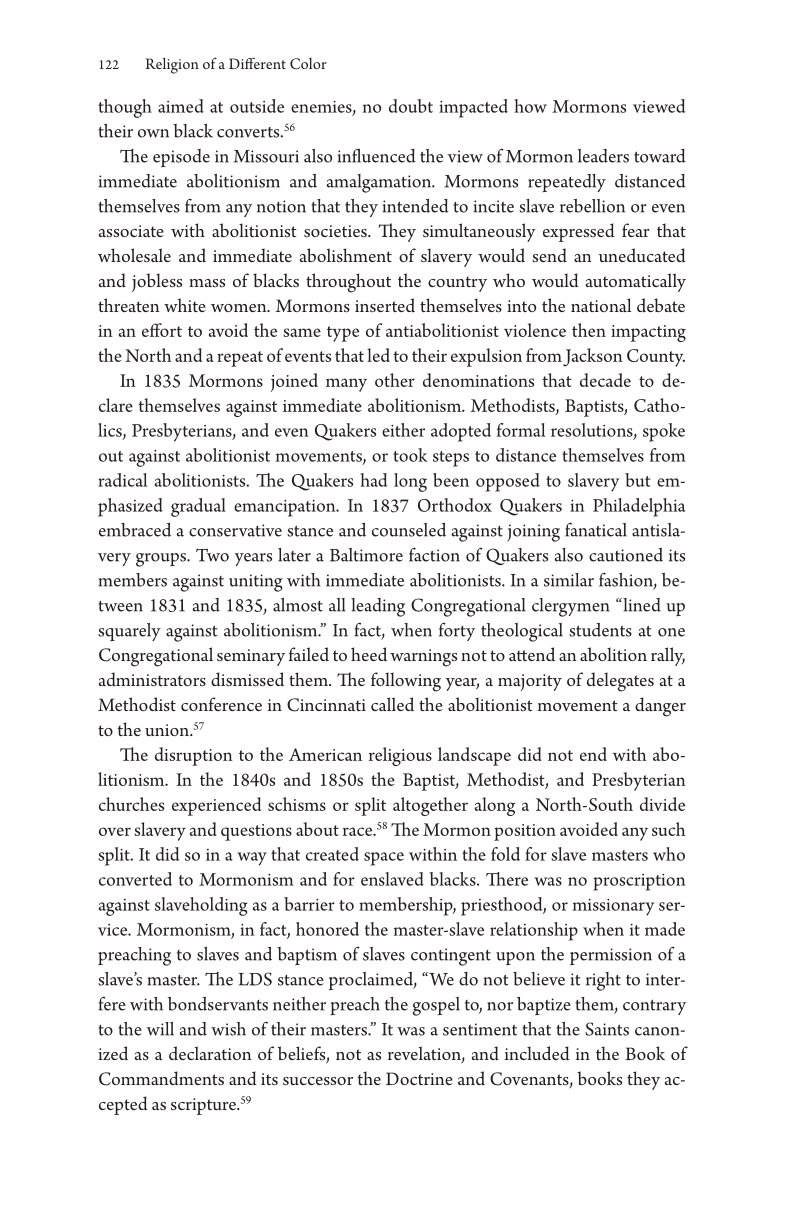Reeve discusses historical reasons for the priesthood ban.
- Type
- Book
- Source
- W. Paul Reeve LDS
- Hearsay
- Secondary
- Reference
W. Paul Reeve, Religion of a Different Color: Race and the Mormon Struggle for Whiteness (New York, NY: Oxford University Press, 2015), 122–123
- Scribe/Publisher
- Oxford University Press
- Audience
- Reading Public
- Transcription
The disruption to the American religious landscape did not end with abolitionism. In the 1840s and 1850s the Baptist, Methodist, and Presbyterian churches experienced schisms or split altogether along a North-South divide over slavery and questions about race. The Mormon position avoided any such split. It did so in a way that created space within the fold for slave masters who converted to Mormonism and for enslaved blacks. There was no proscription against slaveholding as a barrier to membership, priesthood, or missionary service. Mormonism, in fact, honored the master-slave relationship when it made preaching to slaves and baptism of slaves contingent upon the permission of a slave's master. The LDS stance proclaimed, "We do not believe it right to interfere with bondservants neither preach the gospel to, nor baptize them, contrary to the will and wish of their masters." It was a sentiment that the Saints canonized as a declaration of beliefs, not as revelation, and included in the Book of Commandments and its successor the Doctrine and Covenants, books they accepted as scripture.
While carving out this position in the mid-1830s was politically expedient and even perceived as necessary to prevent the same type of violence that led to the Mormon expulsion from Jackson County, it simultaneously helped to create the circumstances that would lead to Brigham Young's announcement of the priesthood ban in 1852. Young's announcement was made to the Utah territorial legislature as it considered how to deal with the issue of slavery, an issue that was relevant only because slaveholders from the South converted to Mormonism, as did some of their slaves, and then moved to the Great Basin with the rest of the Saints. The decision in the 1830s that attempted to maintain an open gospel message for slave masters and slaves alike, while simultaneously avoiding the perceived pitfalls of immediate abolitionism, had consequences that were perhaps intended. It avoided the split or schism that tore the Methodists, Baptists, and Presbyterians apart, even as it created the circumstances—the inclusion of slaves and slave masters in the Mormon fold—that would later lead Brigham Young to split the lay priesthood along racial lines. It was a case of the universal Mormon message casting a net wide enough to incorporate "black and white, bond and free" (2 Nephi 26:33) and then sorting those who responded according to prevailing cultural notions of racial superiority, white and free over black and bound. The very universalism of the opening decades of Mormonism laid the groundwork for the later racial constriction.
The B. H. Roberts Foundation is not owned by, operated by, or affiliated with the Church of Jesus Christ of Latter-day Saints.

